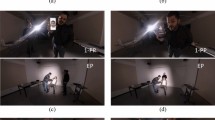Abstract
We present a hybrid remote rendering method for applications on mobile devices. In our remote rendering approach, we adopt a client-server model, where the server is responsible for rendering high-fidelity models, encoding the rendering results and sending them to the client, while the client renders low-fidelity models and overlays the high-fidelity frames received from the server on its rendering results. With this configuration, we are able to minimize the bandwidth requirements and interaction latency, since only key models are rendered in high-fidelity mode. We perform a quantitive analysis on the effectiveness of our method. Moreover, we conduct a user study on the subjective and objective effects of our method on the user experience. The results show that key model fidelity has a significant influence on the objective difficulty, while interaction latency plays an important role in the subjective difficulty. The results of the user study show how our method can benefit the users while minimizing resource requirements.










Similar content being viewed by others
References
Bao P, Gourlay D (2006) A framework for remote rendering of 3-d scenes on limited mobile devices. IEEE Trans Multimed 8(2):382–389. https://doi.org/10.1109/TMM.2005.864337
Bao P, Gourlay D, Li Y (2006) Deep compression of remotely rendered views. IEEE Trans Multimed 8(3):444–456. https://doi.org/10.1109/TMM.2006.870746
Boukerche A, Pazzi RWN (2006) Remote rendering and streaming of progressive panoramas for mobile devices. In: Proceedings of the 14th annual ACM international conference on multimedia, multimedia ’06, pp 691–694
Cecil J, Ramanathan P, Rahneshin V, Prakash A, Pirela-Cruz M (2013) Collaborative virtual environments for orthopedic surgery. In: 2013 IEEE international conference on automation science and engineering (CASE), pp 133–137. https://doi.org/10.1109/CoASE.2013.6654045
Chang CF, Ger SH (2002) Enhancing 3d graphics on mobile devices by image-based rendering. In: Inproceedings of the 3rd IEEE pacific rim conference on multimedia: Advances in multimedia information processing, PCM ’02, pp 1105–1111
Chang CL, Girod B (2004) Receiver-based rate-distortion optimized interactive streaming for scalable bitstreams of light fields. In: 2004 IEEE International Conference on Multimedia and Expo (ICME) (IEEE Cat. No.04TH8763), vol 3, pp 1623–1626. https://doi.org/10.1109/ICME.2004.1394561
Chen KT, Chang YC, Hsu HJ, Chen DY, Huang CY, Hsu CH (2014) On the quality of service of cloud gaming systems. IEEE Trans Multimed 16 (2):480–495. https://doi.org/10.1109/TMM.2013.2291532
Chen SE (1995) Quicktime vr: An image-based approach to virtual environment navigation. In: Proceedings of the 22Nd annual conference on computer graphics and interactive techniques. ACM, New York, pp 29–38. https://doi.org/10.1145/218380.218395
Crassin C, Luebke D, Mara M, McGuire M, Oster B, Shirley P, Sloan PP, Wyman C (2015) CloudLight: A system for amortizing indirect lighting in real-time rendering. J Comput Graph Techniques (JCGT) 4(4):1–27. http://jcgt.org/published/0004/04/01/
Garland M, Heckbert PS (1997) Surface simplification using quadric error metrics. In: Proceedings of the 24th annual conference on computer graphics and interactive techniques. ACM Press/Addison-Wesley Publishing Co., New York, pp 209–216. https://doi.org/10.1145/258734.258849
Hemmati M, Javadtalab A, Nazari Shirehjini AA, Shirmohammadi S, Arici T (2013) Game as video: Bit rate reduction through adaptive object encoding. In: Proceeding of the 23rd ACM workshop on network and operating systems support for digital audio and video. ACM, New York, pp 7–12. https://doi.org/10.1145/2460782.2460784
Hong HJ, Hsu CF, Tsai TH, Huang CY, Chen KT, Hsu CH (2015) Enabling adaptive cloud gaming in an open-source cloud gaming platform. IEEE Trans Circuits Syst Video Technol 25(12):2078–2091. https://doi.org/10.1109/TCSVT.2015.2450173
Lamberti F, Sanna A (2007) A streaming-based solution for remote visualization of 3d graphics on mobile devices. IEEE Trans Vis Comput Graphics 13:247–260
Levoy M (1995) Polygon-assisted jpeg and mpeg compression of synthetic images. In: Proceedings of the 22Nd annual conference on computer graphics and interactive techniques. ACM, New York, pp 21–28. https://doi.org/10.1145/218380.218392
Liu C, Jia J, Zhang Q, Zhao L (2017) Lightweight WebSIM rendering framework based on cloud-baking. Proceedings of the 2017 ACM SIGSIM conference on principles of advanced discrete simulation - SIGSIM-PADS ’17 pp 221–229. http://dl.acm.org/citation.cfm?doid=3064911.3064933
Liu Y, Wang S, Dey S (2014) Content-aware modeling and enhancing user experience in cloud mobile rendering and streaming. IEEE Trans Emerg Sel Topics Circuits Syst 4:43–56
Lu Y, Li S, Shen H (2011) Virtualized screen: A third element for cloud-mobile convergence. IEEE Multimed 18:4–11
Lu Y, Liu Y, Dey S (2017) Asymmetric and selective object rendering for optimized cloud mobile 3d display gaming user experience. Multimed Tools and Appl 76(18):18,291–18,320. https://doi.org/10.1007/s11042-016-3798-z
Ma Z, Yue T, Cao X, Xu Y, Li X, Wang Y (2017) Interactive screen video streaming-based pervasive mobile workstyle. IEEE Trans Multimed 19(10):2322–2332. https://doi.org/10.1109/TMM.2017.2737944
Noimark Y, Cohen-Or D (2003) Streaming scenes to mpeg-4 video-enabled devices. IEEE Comput Graph Appl 23(1):58–64. https://doi.org/10.1109/MCG.2003.1159614
Shi S, Hsu CH (2015) A survey of interactive remote rendering systems. ACM Comput Surveys 47:57
Shi S, Nahrstedt K, Campbell R (2012) A real-time remote rendering system for interactive mobile graphics. ACM Trans Multimed Comput Commun Appl (TOMCCAP) 8(46):43–56
Simoens P, Joveski B, Gardenghi L, Marshall IJ, Vankeirsbilck B, Mitrea M, Prêteux F, De Turck F, Dhoedt B (2012) Optimized mobile thin clients through a mpeg-4 bifs semantic remote display framework. Multimed Tools and Appl 61(2):447–470. https://doi.org/10.1007/s11042-011-0849-3
Slivar I, Suznjevic M, Skorin-Kapov L (2015) The impact of video encoding parameters and game type on qoe for cloud gaming: A case study using the steam platform. In: 2015 7th international workshop on quality of multimedia experience (QoMEX), pp 1–6. https://doi.org/10.1109/QoMEX.2015.7148144
Suznjevic M, Slivar I, Skorin-Kapov L (2016) Analysis and qoe evaluation of cloud gaming service adaptation under different network conditions: The case of nvidia geforce now. In: 2016 8th international conference on quality of multimedia experience (QoMEX), pp 1–6. https://doi.org/10.1109/QoMEX.2016.7498968
Zhu W, Hou YT, Wang Y, Zhang YQ (1998) End-to-end modeling and simulation of mpeg-2 transport streams over atm networks with jitter. IEEE Trans Circuits Syst Video Technol 8(1):9–12. https://doi.org/10.1109/76.660823
Author information
Authors and Affiliations
Corresponding author
Additional information
Publisher’s note
Springer Nature remains neutral with regard to jurisdictional claims in published maps and institutional affiliations.
Rights and permissions
About this article
Cite this article
Sun, L., Osman, H.A. & Lang, J. A hybrid remote rendering method for mobile applications. Multimed Tools Appl 79, 3333–3358 (2020). https://doi.org/10.1007/s11042-019-7306-0
Received:
Revised:
Accepted:
Published:
Issue Date:
DOI: https://doi.org/10.1007/s11042-019-7306-0




